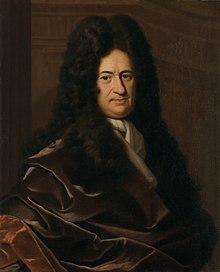Christoph Bernhard Francke
Christoph Bernhard Francke (also Bernhard Christoph Francken ; * about 1660 to 1670 in Hannover ; † 18th January 1729 in Braunschweig ) was a German was an officer and painter of the Baroque .
Life

painting around 1700,
Herzog Anton Ulrich Museum, Braunschweig
Little reliable is known about Christoph Bernhard Francke's origins. It is believed that he was born in Hanover in the 1660s. He is said to have received an artistic training in Italy.
In 1693 he entered the service of Duke Rudolf August von Braunschweig-Wolfenbüttel as a lieutenant , but in the following years he worked mostly as a court painter at the court in Wolfenbüttel . Nevertheless, in 1702 he took part in a campaign against the Electorate of Hanover as an officer in Rudolf August's body regiment .
By 1699 at the latest, the year of his marriage, he settled down as a painter in the city of Braunschweig and moved into a house on the Aegidienmarkt . On May 4, 1699 he married Agnesa Benedicta Duve (1680–1727), daughter of the theologian and pastor of St. Aegidien Achatius Duve (1644–1698). The marriage had eight children, three of whom the parents survived.
Francke enjoyed a high reputation in the principality. In 1700 Rosine Elisabeth , the morganatic wife of Duke Rudolf August, was godmother of his first child and in 1715 the reigning Duke August Wilhelm was godfather of a son. In the same year August Wilhelm officially appointed him "princely art and portrait painter".
Christoph Bernhard Francke died on January 18, 1729 in Braunschweig and was buried in the garrison cemetery in front of the Aegidientor , on today's Wolfenbütteler Strasse. The cemetery is no longer preserved.
plant
It is believed that Christoph Bernhard Francke worked as a portrait painter exclusively on behalf of the Dukes of Braunschweig-Wolfenbüttel. His surviving works mostly show members of the extensive royal family. A portrait of Tsarevich Alexei of Russia in the picture gallery at Salzdahlum Castle is reported. The Russian Crown Prince had become the son-in-law of Duke Ludwig Rudolf through his marriage to Charlotte Christine von Braunschweig-Wolfenbüttel . The painting is now considered lost.
Probably Francke's best-known work shows the philosopher, scientist and historian Gottfried Wilhelm Leibniz , who was the librarian of the Herzog August Library in Wolfenbüttel from 1691 to 1716 . The painting is now in the collection of the Herzog Anton Ulrich Museum in Braunschweig.
literature
- Horst-Rüdiger Jarck , Dieter Lent et al. (Ed.): Braunschweigisches Biographisches Lexikon - 8th to 18th century . Appelhans Verlag, Braunschweig 2006, ISBN 3-937664-46-7 , p. 226-227 .
- Paul Jonas Meier : Bernhard Christoph Francken. A Braunschweig portrait painter in the 1st third of the 18th century . In: Yearbook of the history association for the Duchy of Braunschweig. Julius Zwissler, Wolfenbüttel 1916, pp. 100-112.
Web links
Individual evidence
- ^ Georg Seebaß, Friedrich-Wilhelm Freist: The pastors of the Braunschweig Evangelical Lutheran Church since the Reformation was introduced . Regional church office of the Braunschweigische Ev.-Luth. Regional Church, Wolfenbüttel 1969.
- ↑ Holger Wittig: The princely pleasure palace Salzdahlum . Volume 1, Norderstedt 2005, ISBN 3-8334-0591-0 . P. 130.
| personal data | |
|---|---|
| SURNAME | Francke, Christoph Bernhard |
| ALTERNATIVE NAMES | Francke, Bernhard Christoph; Francken, Christoph Bernhard; Francken, Bernhard Christoph; Francke, Bernhard; Francken, Bernhard |
| BRIEF DESCRIPTION | German officer and painter |
| DATE OF BIRTH | between 1660 and 1670 |
| PLACE OF BIRTH | Hanover |
| DATE OF DEATH | January 18, 1729 |
| Place of death | Braunschweig |

